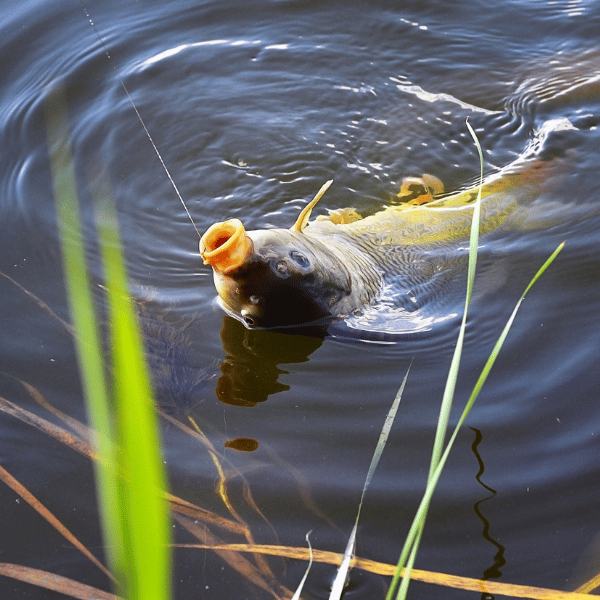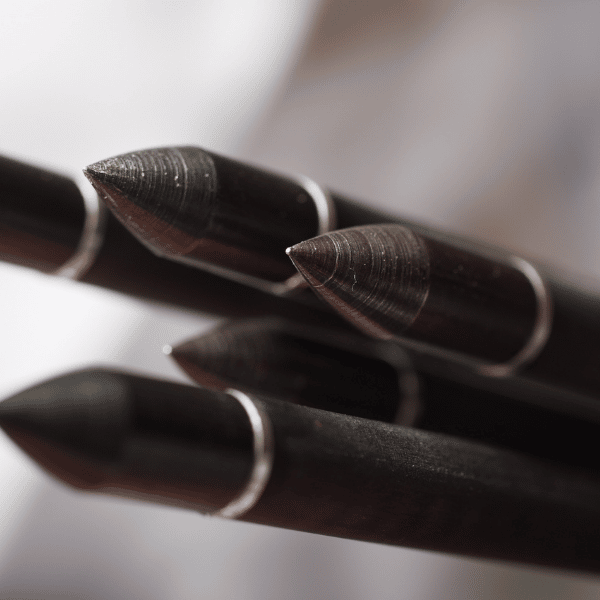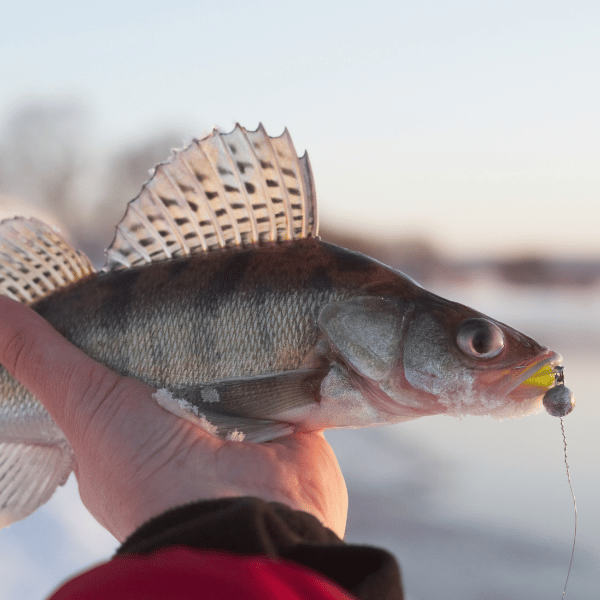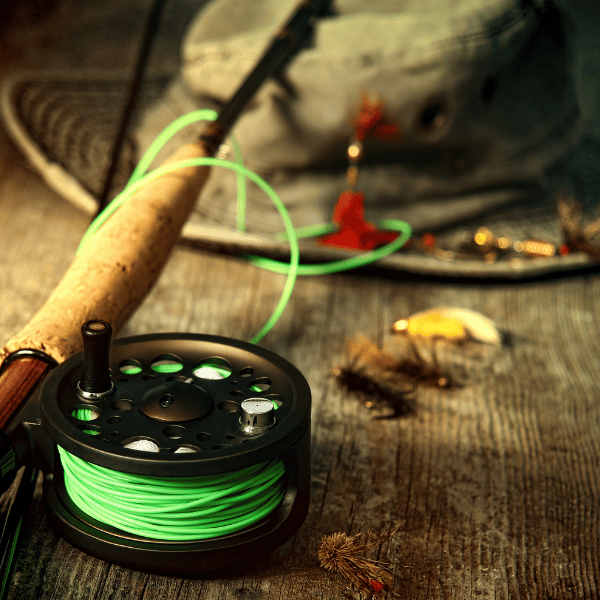Jigging Vs Tip Ups for Walleye Ice Fishing
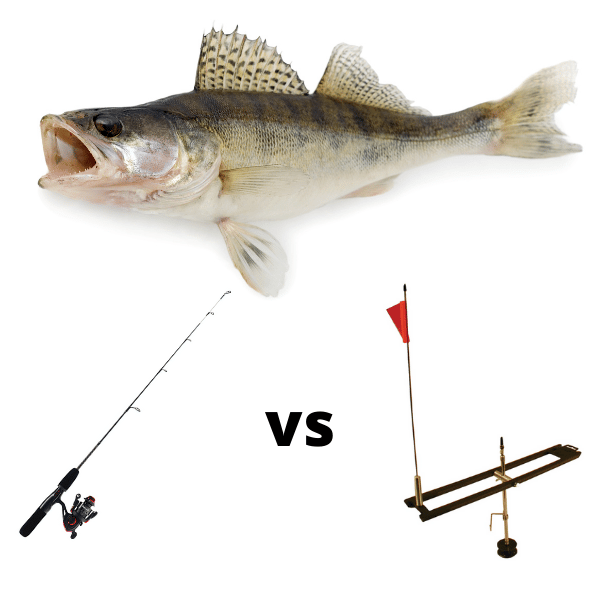
Jigging is better when walleye are more passively eating during the day. When walleye are more active around sunset, tip-up ice fishing for walleye can be more beneficial by covering more ice. Doing a combination of both jigging and tip-up ice fishing for walleye will be your best bet, but the ability to do both at one time depends on your local fishing regulations.
In this article we will dive into this a bit more to give you a better understanding of when is jigging better for walleye ice fishing vs tip-up ice fishing, and when can tip-ups be better than jigging for walleye.
Contents
Walleye Ice Fishing – What They Like
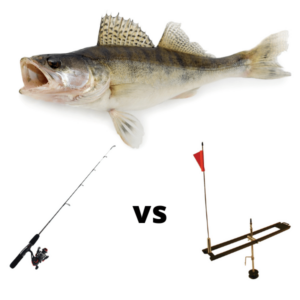
Walleye is a freshwater fish that is in the perch family and is a popularly stocked game fish that loves cool water, making it a great choice for those interested in ice fishing.
Ice fishing for walleye can be a great experience. Walleye is a great food fish, especially around the sizes of 12-15 inches. Walleye can also be fished recreationally in a catch-and-release fashion.
Whether you prefer to eat them or release them, it can be great fun. Walleye is a very popular choice for ice fishers because of its overall activeness and aggressiveness in water temperatures where other fish would not be a fun catch.
Traditionally, two of the most popular methods for walleye ice fishing involve the use of jigging or tip-ups. Both methods have some ups and downs, and both can be very effective if done correctly.
Here, we will take a look at these two options and why you may want to use either on any given trip.
Walleye Jigging vs Tip Ups
Choosing between jigging and tip-ups requires the consideration of several different things, as both have their own advantages and disadvantages.
Tip-ups come in all sorts of shapes and sizes, but all share a single characteristic: they are designed to be used as stationary (or set) lines.
The simplest form of a tip-up is derived from a classic style that involves three crossed wood beams of less than an inch in thickness.
The more advanced setups—which will obviously cost more—allow the angler to cover various depths of water to maximize the chance of getting a bite.
A larger, higher-quality tip-up rig is great fun, but the smaller and cheaper ones are very prone to breakage and can be a hassle at times.
When jigging, you are using a type of fishing lure referred to as a jig. This consists of a lead sinker with a hook molded into it, usually covered by something that will attract fish.
This is a versatile solution for anglers and requires a bit more manual action to get yourself a bite. This is a more active version of ice fishing than tip-ups, in most cases.
Both options allow you to choose your bait, and a good bait will work well on either rig. To decide which method you will want to use requires a little bit of understanding and thought about the differences between the two systems.
When is Walleye Jigging Better Than Tip Ups?
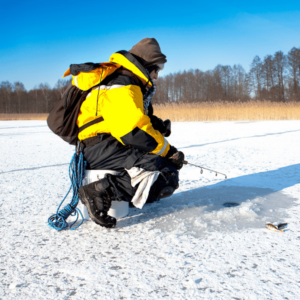
So our first question is: when is it you may want to go jigging as opposed to setting up a tip-up rig?
One thing to consider is what you are fishing for. Some fish just plain prefer their prey to have little to no movement.
Jigging is not a very good choice for when your preferred catch prefers bait like this. On the other hand, for the types of fishing where the desired fish doesn’t mind or enjoys movement, jigging is the way to go for sure.
In general, when it comes to walleye, you are likely going to have a more productive time jigging as opposed to just using tip-ups. Walleye will go for naturally moving bait, and this is where jigging shines most.
Also, jigging will help to call the walleye to the area. If the population you are fishing for is inactive in the particular area you settled in, getting good with jigging will help call them over and give you a much better chance of getting one on the hook.
So, if you are looking to catch walleye as quickly and effectively as possible, then jigging is your best bet. If you’re short on time or desperate for a catch, this is probably your best bet.
There are other times, however, where having a nice and relaxed experience with some good friends might be more important than the catch itself. Decide for yourself what your goal is and plan accordingly.
When Are Tip Ups Better Than Jigging for Walleye?
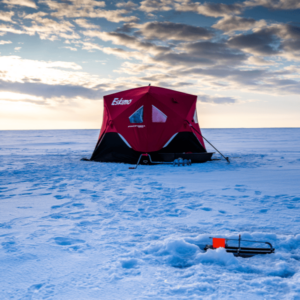
So if jigging is a generally more effective way of ice fishing walleye, why consider using tip ups? Well, it depends on what you have planned for your ice fishing trip.
The first thing that may come to mind is leisure. While jigging requires persistent action, once a decent-quality tip-up is set up, you have plenty of time to relax and let the rig do what it will do.
This makes tip-up ice fishing a bit more relaxing and generally better in situations where you are out with some friends and care more about the overall experience than the actual results.
Having a few beers with some good friends and good conversation can be better enjoyed when you have less to be actively focused on.
Also, tip-ups can serve as an excellent backup—giving you the chance to enjoy the best of both worlds. There is absolutely no reason that you cannot use jigging and tip-ups together, and this is actually a very common practice when walleye ice fishing.
All you have to do is set up your tip-ups, as many as you would like in as many different holes as you wish, and then you can focus on actively jigging. This will bring fish to the area, while also increasing your chances as you will have multiple points from which you may hook your walleye.
When arguing efficiency, interestingly enough, this is a major point in favor of tip-ups. While jigging is actively more effective, tip-ups can increase your chances in a totally different way.
Remember, you can set up many tip-ups, especially if you have some extra help looking after the lines once they are set.
More tip-ups translate to more bait and more hooks. This means more chances to catch yourself a walleye.
Walleye Jigging vs Tip Up FAQ
If you are using tip-ups, concentrate your lines somewhere between the 6-12 foot range for more shallow lakes and around 10-20 feet for larger clear lakes. When settings the bait, you may want to go as low as 4 to 8 inches from the bottom of the water you are fishing—the deeper the water, however, may require you to go as high as 20 inches from the bottom.
Check out our full guide on How to Walleye Ice Fish with a Tip-Up for more details on depths for ice fishing for walleye with a tip-up.
Check out our full guide on How to Jig for Walleye in Winter for more details on depths for jigging for walleye.
As with most fishing, you can expect to find the most activity during the times just before sunrise and just after sunset.
Walleye specifically feed most actively at night than during the day, so right after sunset is a great time to be ready to fish.
Walleye feeding is triggered by light. Almost any ice angling veteran will tell you that the 90 minutes around dusk and overcast days will give you the most success.
If there is too much light, the walleye will not want to bite. When the light is low, however, walleye are going to be looking around for a meal.
Check out our Beginner Guide to Ice Fishing Walleye for more details on walleye ice fishing at various times of the day, weather conditions, and more.
Look for spots like gravel bars and rocky drop-offs. Also, weed edges and mudflats are a good place to check as well.
Check out our full guide on How to Find Walleye Ice Fishing for more details.
In the early season, walleye can be aggressive. Because of this, it may be a good idea to use a larger size hook. A #1 wide gap is a safe bet for these aggressive, early-season walleye.
Check out our full guide on Best Lures, Jigs, & Baits for Walleye Ice Fishing for more details.
